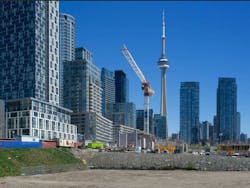When you think of “archaeology,” you might picture Indiana Jones racing from a remote cave, clutching a priceless golden idol. Or maybe a team of researchers sifting through the sands of Egypt to uncover an ancient Pharaoh’s tomb. But you likely don’t think about the people digging up the parking lot behind your apartment or office building. That’s urban archaeology---the exploration that goes on in our cities. Believe it or not, there’s a whole world of artifacts below our city streets. Artifacts that help tell the stories of our neighborhoods and our heritage. Now, for the first time, the City of Toronto is exploring how to bring its archaeological collections together in a central place. But what would such a location look like? How could it be designed to give historians—and average citizens—a glimpse into our city’s past? I have a few ideas.
First, you might be asking if artifact archives are necessary. Are there enough artifacts to warrant them? Do people really care about the past? From my experience, I can answer with an emphatic “Yes!”
Archaeological assessments are common in cities like Toronto where they’re often a requirement for developers applying for building permits. Any growing city will have a similar opportunity to uncover the past and preserve thousands of artifacts. From what I’ve experienced, Torontonians have proven deeply interested in the heritage beneath their feet.
On one of my team’s recent archaeological excavations in a downtown Toronto parking lot, curious passersby often peered over the security fence to watch us dig. People always joked, saying things like, “Find any gold?” Or, “Is this where Jimmy Hoffa is buried?” But, all kidding aside, most people are genuinely interested in learning about our findings. I put down my trowel more than once to chat with people at the fence and explain, “Those walls you see? Those are 19th century stone foundations. That smell? It comes from a 19th century outhouse we discovered. And right over there? That’s where we found a pair of shoes dating from the 1860s.”
But after the artifacts are dug out of the ground, what comes next? Today, many municipalities are grappling with how to take care of their artifacts and preserve them for future study. While archaeological finds abound in a City like Toronto, they’re not currently housed in a single location. Currently, artifacts—whether pottery, shoes, furniture, or glassware—are documented and stored by the licensed consulting archaeologists who discover them. They wind up kept in offices, storage lockers, garages, and basements. What good are archaeological excavations and keeping all this stuff if no one looks at it and our stories remain buried in boxes?
As Toronto begins exploring how to house its artifacts, the City will first determine the volume of material currently stored by consultant archaeologists. Then, and more importantly, the City will need to estimate the projected growth of archaeological collections over the next 10 years. Once this data is gathered, a city-owned facility will be recommended and adapted for the long-term storage of artifacts and records. Such a facility would both protect artifacts unearthed in the City and create a central hub for researchers and maybe even make them available to the wider public. While one shoe from the 1860s might give us a glimpse of our past, studying all the 19thcentury shoes dug up in Toronto lets us really say something about their manufacture, the artisans, the economy, and our collective past.
As an archeologist and citizen, here is my wish list of three things cities like Toronto—and other cities—should consider when planning for how to collect and preserve their artifacts and create a meaningful heritage experience:
- Site summaries - One of the most frequently asked questions I get while digging in Toronto is “Where can I read about the excavation?” Full excavation reports exist for every site in the province, and these are available through the Ministry of Tourism, Culture and Sport (MTCS). But these reports are more academic than accessible. An easy-to-read summary of the excavation results is a must.
- Excavation photo archive: If you have never been to the City of Toronto’s archive website, you are in for a treat. For me, searching the photographic archive provides an intimate look at the history of the city in images. Some excavation and artifact photos could also be included in the archive. After all, Torontonians want to see what a mid-19th century pair of shoes found in an outhouse look like!
- Bring it all together with an app: Imagine the visitor experience of walking through Toronto with a digital map of all the excavated sites in the city. Within the app you could link to those easy-to-read site summaries and photos I mentioned and take a virtual tour of the City’s past.
In Toronto, the world beneath our feet can give us a glimpse into the life in our city from more than a century ago. As an archaeologist—and as a citizen—I look forward to engaging with Toronto’s complete collection of artifacts because we can only fully understand where we are going once know where we have been.
A project archaeologist as well as a member of the Ontario Archaeological Society, the Society of American Archaeology, and the Institute of Nautical Archaeology, Thanos spends a lot of time in the past. With 25 years of experience working with academic institutions and private firms, Thanos has garnered a great amount of expertise, and he’s specialized in zooarchaeology, marine archaeology, and urban archaeology.
About the Author
Stantec
Published by global design firm Stantec, this eclectic blog features viewpoints, insights, and explanations from Stantec architects, engineers, and designers, on a range of issues impacting the fabric of our communities. Our contributors share their thoughts about design trends, emerging technologies, vexing challenges, and inspired solutions. For more blog posts, visit our Ideas page. Follow us on Facebook, Instagram, LinkedIn, and Twitter, and YouTube.


